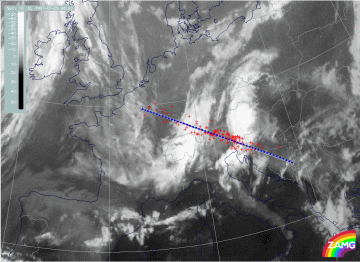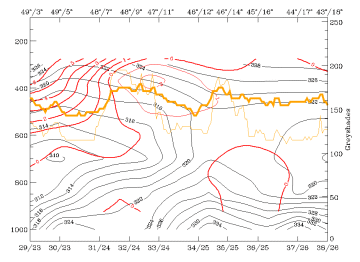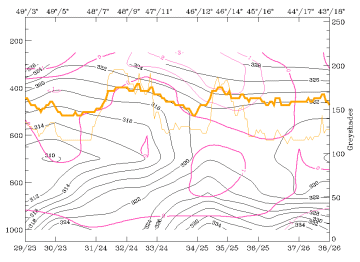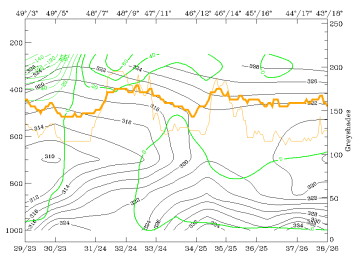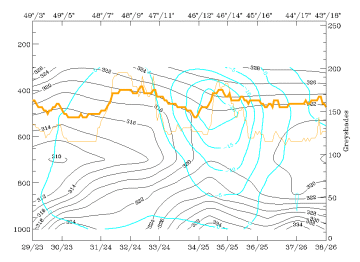29 July 1997 - Diagnosis For 06.00 UTC With Help Of Vertical Cross Sections
|
29 July 1997/06.00 UTC - Meteosat IR image; red: weather observation stations; position of vertical cross section indicated
|
|
Vertical cross sections are an additional, different look into the physical-meteorological state of the troposphere which sometimes enhances or even detects special situations. The image above shows the course of the chosen vertical cross section from France across both cloud systems discussed before, i.e. across the area of Jet Intensification (compare Conceptual Models: Front Intensification by Jet Crossing ) in the western, and the area of convergence and Cb activity in the eastern cloud system. The red crosses represent weather stations within a pre-selected distance from the cross section line which are projected vertically on this line for a better representation of the situation at the surface. The grid in cyan and black is related to grid-points of the numerical model of ECMWF used for these purposes.
|
29 July 1997/06.00 UTC - Vertical cross section; black: isentropes (ThetaE), red thin: temperature advection - CA, red thick:
temperature advection - WA, orange thin: IR pixel values, orange thick: WV pixel values
|
29 July 1997/06.00 UTC - Vertical cross section; black: isentropes (ThetaE), magenta thin: divergence, magenta thick: convergence,
orange thin: IR pixel values, orange thick: WV pixel values
|
|
29 July 1997/06.00 UTC - Vertical cross section; black: isentropes (ThetaE), green thick: vorticity advection - PVA, green thin:
vorticity advection - NVA, orange thin: IR pixel values, orange thick: WV pixel values
|
29 July 1997/06.00 UTC - Vertical cross section; cyan thick: vertical motion (omega) - upward motion, cyan thin: vertical motion
(omega) - downward motion, magenta thin: divergence, magenta thick: convergence, orange thin: IR pixel values, orange thick: WV pixel
values pixel values
|
The images above show the vertical distribution of relevant parameters for both cloud systems which show up as broad maxima of the orange lines: the western one around gridpoint 32/24, the eastern one around gridpoint 35/25. The most important facts are summarised as follows:
- There is no notable temperature advection in the top left image, especially in the eastern system, but two interesting facts can be
recognised:
- In the eastern system where there are thunderstorm events there is (weak) WA below and CA above, which is a typical configuration for instability
- The western system is under CA between 500 and 300 hPa, which fits well to the upper level trough situation described before.
- Both cloud systems are accompanied by configurations of isentropes which are typical for a very unstable troposphere; although isentropes do not reveal any normal frontal characteristics, there is a suggestion of a weak upper level Cold Front inclined downward from 300 to 400 hPa between the two cloud systems.
- Both cloud systems are also accompanied by convergence in a thick layer (right image top). In particular the eastern cloudiness, the Convergence Cloudiness (compare Conceptual Models: Convergence Cloudiness ), shows appreciable convergence between 900 and 500 hPa.
- A maximum of PVA at 300 hPa (left image bottom) is superimposed on the western cloud system and represents the PVA in the left exit region of the jet streak discussed in more detail previously (compare Diagnosis of the eastern cloud feature - Conceptual models "Convergence Cloudiness" and "Cumulonimbus (Cb) and Mesoscale Convective System (MCS)" and Conceptual Models: Front Intensification by Jet Crossing ).
- Although the whole area is an area of upward motion (right image bottom: negative values of omega) the main rising happens at this point of time with the eastern system in connection within the convergence there.
